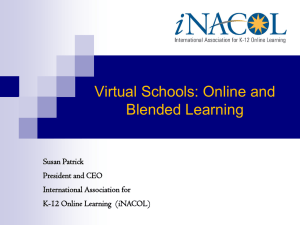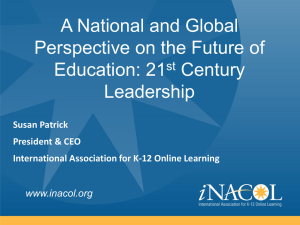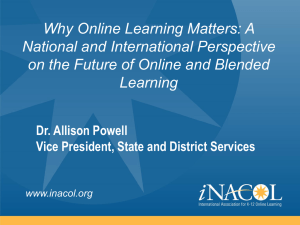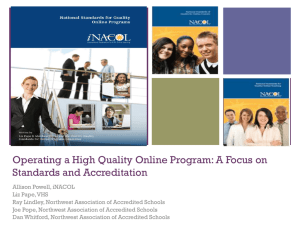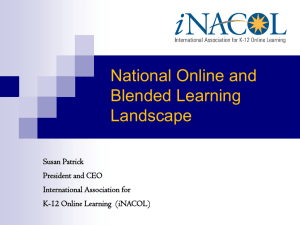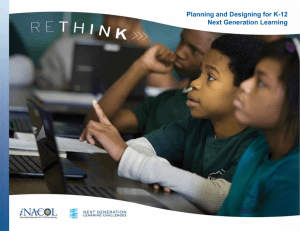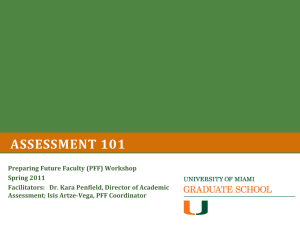Maria Worthen - Alternative Accountability Policy Forum
advertisement
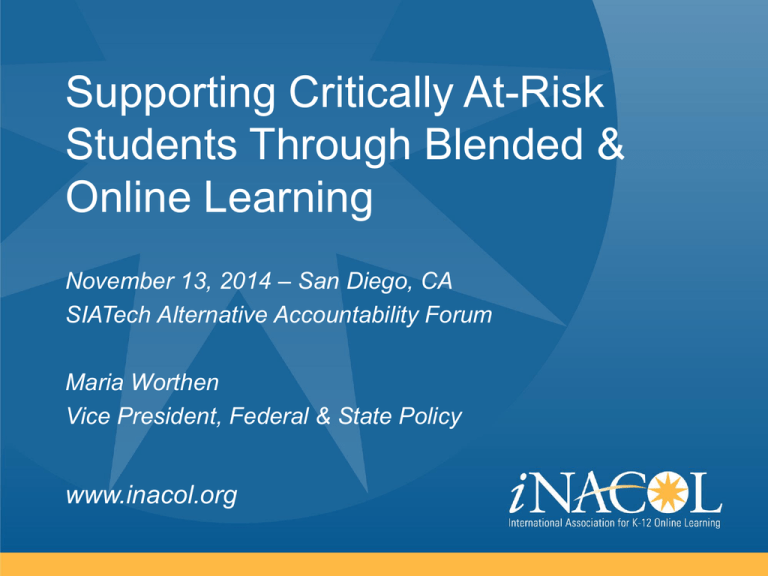
Supporting Critically At-Risk Students Through Blended & Online Learning November 13, 2014 – San Diego, CA SIATech Alternative Accountability Forum Maria Worthen Vice President, Federal & State Policy www.inacol.org iNACOL’s Mission To ensure all students have access to a world-class education and quality blended and online learning opportunities that prepare them for a lifetime of success. Galaxy of Members Blended Schools Parents 3,361 Teachers & Educators State Virtual Schools Full-time Online Schools Colleges & Universities Think Tanks Public School Districts Regional Education Agencies Policy Makers International Programs Non-profit/ Associate OER Next Generation Learning Partners Online Content Providers Tech Tools Providers EMOs Part-time Online Programs Researchers & Evaluators www.inacol.org Philanthropy/ Foundations State Departments of Education Tutoring/S ervices Private & Independent Schools iNACOL State Policy Frameworks • Create competency-based education systems • Improve student access and equity – access to blended & online learning • Measure and assure quality from inputs to outcomes • Support innovative educators & schools • Support new learning models through connectivity, data systems, and security It’s About Equity: High-Quality Opportunities for All Students Traditional Public/Private Accelerated Students Credit Recovery Medically Fragile Need to work and/or support family Rural Students ELL Special Education Aspiring athletes and performers The Opportunity Gap • US high schools offering – Calculus: 50% – Physics: 63% • US high schools that don’t offer full sequence of Algebra I and II, Geometry, Biology, Chemistry: 10-25% • High schools with the highest percentage of black and Latino students – 1/4 do not offer Algebra II – 1/3 do not offer Chemistry. Source: US Department of Education Office for Civil Rights. (March 2014) New Solutions through Online Learning • 40% of US high schools do not offer AP courses – 75% of districts use online learning to offer Advanced Placement or college-level courses. • Teacher Shortages – 40% of public school districts in America today say they need online learning resources because certified teachers are not available for traditional face-to-face instruction. • 60% of schools and districts say they need online learning for credit recovery. • More than 50% need online learning to reduce student scheduling conflicts to graduate on time. Competenc y End of grading period Time Credit: Steve Kossakoski, New Hampshire Virtual Learning Academy Competenc y Time Credit: Steve Kossakoski, New Hampshire Virtual Learning Academy 5-Part Working Definition: Competency-based Learning 1. 2. 3. 4. 5. Students advance upon mastery. Competencies include explicit, measurable, transferable learning objectives that empower students. Assessment is meaningful and a positive learning experience for students. Students receive timely, differentiated support based on their individual learning needs. Learning outcomes emphasize competencies that include application and creation of knowledge, along with the development of important skills and dispositions. - from S. Patrick, C. Sturgis. Cracking the Code; www.CompetencyWorks.org In a proficiency system, failure or poor performance may be part of student’s learning curve, but it is not an outcome. -Proficiency Based Instruction and Assessment, Oregon Education Roundtable State Virtual Schools (2014) Fully Online Schools (2014) Research Highlights • U.S. Department of Education study of Online Learning, “Evaluation of Evidence-based Practice in Online Learning: A Meta-Analysis and Review of Online Learning Studies” (2009) • “Overall, the meta-analysis found that students who took all or part of their class online performed better, on average, than those taking the same course through traditional face-to-face instruction.” • “instruction combining online learning with face-to-face elements had a larger advantage . . .students the participated in online learning and who spent more time on task benefited the most.” Harvard Study: Florida Virtual School • “We do not find any evidence of negative effects of virtual education on student learning, and a finding of equivalent quality, on average, between FLVS and non-FLVS courses may suggest a higher level of productivity in the FLVS courses” Quality Assurance & Accountability for Online Learning www.inacol.org Making Data Work for Students Inputs National Standards of Quality Teaching & Learning • Assess upon entry • Learning GPS • Continuous improvement • Formative, progress monitoring & summative assessment Outcomes Performance Metrics tied to: • Accountability • Funding • Continuation Inputs: iNACOL National Quality Standards Online Courses Online Teaching www.inacol.org Online Programs Teaching & Learning • • • • Assess upon entry Learning GPS Continuous improvement Formative, progress monitoring & summative assessment • Multiple pathways of learning to meet individual learning goals Outcomes: Quality assurance for online schools www.inacol.org Outcome Measures for Full Time Online Schools • Proficiency • Individual student growth along a trajectory • Graduation rates • College and career readiness • Closing the achievement gap • Fidelity to a student’s academic goals Outcome Measures for Supplemental Online Courses • Proficiency • Individual student growth along a trajectory Using Outcome Data • Program improvement • Accountability Next Generation Accountability • All accountability metrics tied to teaching and learning – Competencies aligned to academic standards – Assessment is a positive learning experience • Individual growth along a trajectory • Summative data rolled up from multiple points in time • Incentivize continuous improvement of student learning, rather than “autopsy” Q&A Contact: Maria Worthen mworthen@inacol.org http://www.inacol.org http://www.competencyworks.org www.inacol.org
